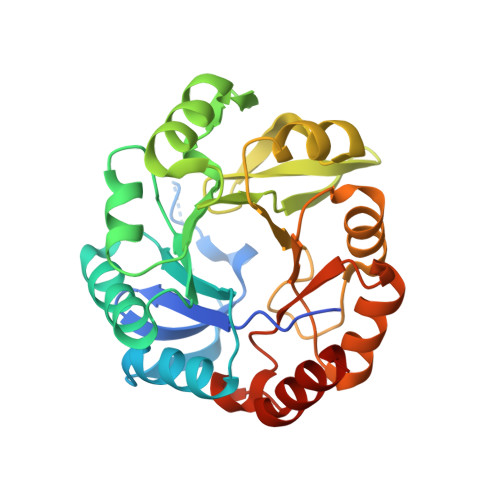Structural, kinetic, and evolutionary peculiarities of HISN3, a plant 5'-ProFAR isomerase.
Witek, W., Imiolczyk, B., Ruszkowski, M.(2024) Plant Physiol Biochem 215: 109065-109065
- PubMed: 39186852
- DOI: https://doi.org/10.1016/j.plaphy.2024.109065
- Primary Citation of Related Structures:
9FCF, 9FCG - PubMed Abstract:
Histidine biosynthesis is essential for the growth and development of plants, where it occurs within chloroplasts. The eleven reactions are catalyzed by eight enzymes, known as HISN1-8, each acting sequentially. Here, we present the crystal structures of a 5'-ProFAR isomerase (HISN3) from the model legume Medicago truncatula bound to its enzymatically synthesized substrate (ProFAR) and product (PrFAR). The active site of MtHISN3 contains a sodium cation that participates in ligand recognition, a feature not observed in bacterial and fungal structures of homologous enzymes. The steady-state kinetics of wild-type MtHISN3 revealed a slightly higher turnover rate compared to its bacterial homologs. Plant HISN3 sequences contain an unusually elongated Lys60-Ser91 fragment, while deletion of the 74-80 region resulted in a 30-fold loss in catalytic efficiency compared to the wild-type. Molecular dynamics simulations suggested that the fragment facilitates product release, thereby contributing to a higher k cat . Moreover, conservation analyses suggested a non-cyanobacterial origin for plant HISN3 enzymes, which is another instance of a non-cyanobacterial enzyme in the plant histidine biosynthetic pathway. Finally, a virtual screening campaign yielded five molecules, with the energy gains ranging between -13.6 and -13.1 kcal/mol, which provide new scaffolds for the future development of herbicides.
- Department of Structural Biology of Eukaryotes, Institute of Bioorganic Chemistry, Polish Academy of Sciences, Noskowskiego 12/14, 61-704, Poznan, Poland.
Organizational Affiliation:




















